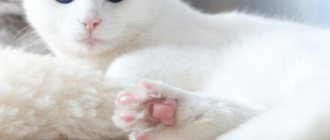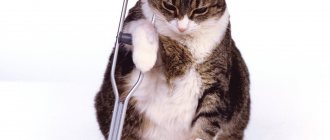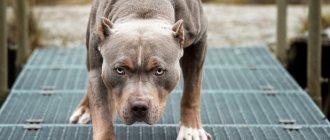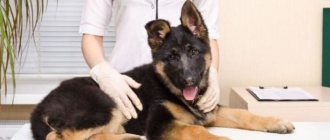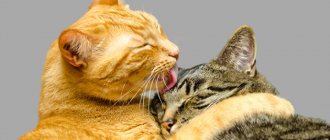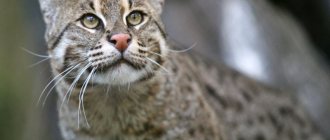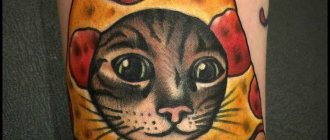A kitten's paw bruise is a common type of mechanical injury. Bruises can affect various parts of the animal's body, including the paws. The result of paw bruises can be pain, limited mobility, disruption of the integrity of blood vessels, and so on.
Bruises occur for various reasons. Cats, and especially active kittens, can injure their paws during
fights with other animals, when falling or unsuccessfully descending from a certain height and in other conditions. Most owners cannot be with their pet all the time. Therefore, there is a possibility that you will miss the moment of getting a bruise on your paw or paws and will only find out about the problem after the cat has limped. It is important to pay close attention to your pet's behavior so as not to miss warning signs.
to detect manifestations of this type of mechanical tissue damage in cats, such as a bruise , especially if the cat is not limping. Getting a bruise on the front or back paw is often accompanied by problems with the circulatory system and internal organs in the pet’s body. Mechanical damage caused by a fall or blow with a blunt heavy object often provokes internal hemorrhages. In turn, in the case of simultaneous external damage to skin tissue, muscles and bones can be exposed to infection.
Dislocation of limbs in cats: causes
Dislocation of limbs in cats
Dislocation of joints (displacement) occurs more often in cats of large breeds, and common causes include:
- Impacts resulting from a fall from a great height;
- Careless handling of cats by children (if a child tries to forcibly hold the paw of an animal that does not want to play);
- Out of curiosity, kittens touch moving mechanical objects, stick their paws into cracks, etc.
Less common are congenital dislocations due to dysplasia (abnormal intrauterine development). Animals that develop osteoporosis and rickets due to poor nutrition are more likely to injure their paws.
But, whatever the nature of the injury, congenital or mechanical, in order not to harm the animal and not cause additional physical suffering, you need to seek help from a specialist.
Joint diseases
Lameness can be caused by a congenital abnormality of the structure of the joints - dysplasia. In this case, the animal will have difficulty stepping on the affected limb from childhood. Other joint pathologies include arthritis and degenerative changes in the joints of the front paws. As a rule, such diseases are rare and mainly occur in older cats with metabolic disorders, acromegaly or obesity.
Symptoms indicating problems with the front paw of a pet:
- Change in gait.
- Refusal to jump on chairs and other surfaces.
- Lethargy.
- Frequent licking of the sore limb.
When the owner tries to touch the sore paw, the cat reacts sharply, pulling it away, running away or hissing. If this condition persists for more than a few days, you should contact your veterinarian as soon as possible. To make a diagnosis, the doctor will palpate and examine the affected limb. Radiography is mandatory.
Dislocation in a cat: main symptoms, first aid
“Closed” limb injuries in cats are difficult to detect. These animals have an increased “margin of safety”: in predators, even domesticated ones, the production of endorphin begins, which dulls pain, and the cat can not limp for a long time.
Meanwhile, the period during which the damage to the paws was discovered and before contacting the veterinary clinic determines the treatment tactics, the recovery period, and the consequences of the injury.
Be sure to read:
What is the reason and what to do if a cat’s claws peel off?
The main symptoms that should alert cat owners:
- The most severe injuries are externally manifested within 2-3 hours by redness of the skin around the joint, swelling, hematoma (when ligaments are torn), clicks are heard when moving, or the cat does not step on the paw in pain;
- When a dislocation occurs, a depression is noticeable where the head of the joint emerges, and the damaged limb occupies an unnatural position;
- The cat’s behavior changes: the animal tries to “treat” the injured paw by licking, sleeps restlessly, and moves little.
There is no need to “reset” the joint yourself.
Before contacting a veterinarian, the owner can provide first aid:
- Immobilize the injured limb by applying a splint;
- An anesthetic may be given, either orally or intramuscularly;
- Place the cat in a transport basket.
For pain relief when providing first aid, it is better to use special medications for cats - butomidor, ketofen, nalbuphine. As a last resort, if they are not available, you can give an intramuscular injection with analgin (0.3 ml/1 kg of body weight).
It is better not to use tablets, since with the subsequent use of anesthesia, they will cause vomiting and increased salivation.
To relieve shock, an intramuscular injection of prednisolone (0.5 ml) is suitable. Further emergency assistance will be provided by veterinary clinic specialists. Under no circumstances should you massage the site of injury, but on the contrary, try to place the animal in a comfortable position in the basket, without touching the injury, without sudden movements.
There is no need to feed or water the animal before visiting a specialist: you may have to resort to surgery with the introduction of anesthesia (the joint is set under general anesthesia).
In addition, the injury may be accompanied by shock and vascular spasms, which provoke disruption of the liver and kidneys. In these cases, a full stomach can complicate the situation.
If you suspect serious damage to the joints, an immediate visit to the veterinarian is required, as there is a risk of complications (formation of a blood clot and scarring due to contraction of muscle tissue), which will aggravate further treatment and increase the recovery period.
Be sure to read:
The cat's lower lip is swollen: causes, symptoms, what to do, medication and alternative treatment
Types of dislocations
It is difficult for a person who does not have special knowledge to visually determine the presence of a dislocation and assess the severity of the injury and the need to seek help. The situation is complicated by the fact that the animal cannot tell where and how it hurts. If the injury occurred in front of the owner, the prognosis for treatment and restoration of the damaged limb may be more favorable.
It’s worse if the dislocation occurred more than 14 days ago (not a fresh injury), or more than 3 weeks - advanced dislocation can, even after treatment, lead to a chronic disease, and in severe cases - the prognosis is extremely unfavorable, up to the development of sepsis (blood poisoning) , amputation of a limb or death of an animal. Old dislocations can rarely be cured without surgery.
If you do not go to the clinic in a timely manner, muscle atrophy, paresis of the limbs, and chronic lameness develop. Pain and constant discomfort change the cat’s behavior (aggression, disobedience, etc.), which becomes a serious problem for the comfortable coexistence of humans and pets.
Dislocations are classified according to the degree of complexity. If the head of the bone is completely displaced and does not come into contact with another bone, the dislocation is complete, and with additional examination it remains to determine whether there is a ligament rupture (or sprain) or damage to muscle tissue. With incomplete dislocation (subluxation), soft tissue damage, as a rule, does not occur.
Complex dislocation is often accompanied by intra-articular fractures. To return the joint to its previous position in such cases, surgical fixation is required using pins (for the hip or wrist joints) or screws and wires (for the elbow and ankle joints).
A cat is limping on its front leg: how to recognize a fracture or bruise
If the cat is limping, the owner needs to make a preliminary diagnosis in order to develop an algorithm for his subsequent actions.
When a fracture occurs, the following signs are observed:
- the paw swells along the entire length, and not just at the site of injury;
- upon palpation, displacement of the bone or joints is felt;
- the integrity of the skin may be compromised;
- the cat is in severe pain and meows all the time;
- the cat does not try to lean on the broken paw;
- the injured limb looks unnatural.
The bruise is characterized by the following symptoms:
- a hematoma appears at the site of the injury;
- the cat is leaning on a limb, but is limping;
- no displacement of bones or joints;
- skin integrity is preserved;
- the injury site is hot;
- the pet constantly licks the swelling;
- touching the paw causes aggression.
However, the final diagnosis is made by a veterinarian based on the results of an examination and x-ray.
Treatment
The doctor develops a further treatment plan based on the examination picture, including x-ray.
If surgical intervention is necessary, blood (fibrinous) clots and parts of damaged tissue are removed from the site of joint damage. Using special instruments, the head of the joint is returned to its normal position. The affected limb is fixed and immobilized for at least 10 days. If the disease progresses well, the recovery period lasts about a month.
Be sure to read:
The cat has a fever: what to do, reasons, what is the norm, how to bring it down at home, the best methods
During this period, the cat owner must comply with strict treatment regulations prescribed by a specialist. The postoperative period is usually accompanied by weakened immunity of the animal.
Therefore, in addition to regular examinations by a veterinarian, dressings and X-ray examinations, you will need to provide your cat with good care:
- Pay attention to proper nutrition (with the necessary content of vitamins and microelements) and the quality of feed;
- Monitor the cleanliness of the home and the hygiene of the cat’s equipment (feeding bowls, sleeping place), do not allow the animal in the entrance area of the house to come into contact with the owners’ outdoor clothing and shoes, in order to avoid infection;
- If there are small children in the house, you need to limit their interaction with the cat as much as possible in order to provide it with peace and relaxation;
- Give medications regularly, without missing a dose, and follow all procedures prescribed by your doctor.
Mild joint dislocations require recovery of no more than 4-5 days, but this does not mean that the sick cat does not require attention.
Diagnostics in a veterinary clinic
The fact that the pet has been injured is immediately obvious, but a visit to the veterinary clinic is necessary. After examining your pet and conducting a series of diagnostic tests, the veterinarian will determine the extent of the damage and prescribe appropriate treatment.
Necessary diagnostic methods include general and biochemical blood tests, x-rays in two projections, and cardiac echocardiography. In some cases, an abdominal ultrasound is required.
Prevention measures
Of course, you won’t always be able to control your pet to prevent it from getting run over by a car or falling out of a window. However, no one can cancel compliance with basic safety rules. Make sure that your cat does not climb tall trees; close windows and vents during your absence.
After each walk, inspect your pet for injuries. If you suspect a fracture or dislocation, contact your veterinarian immediately.
Home care
If you have witnessed your cat being hit by a car or falling from a great height and you suspect a fracture, you should put a splint on the injured paw. This procedure will immobilize the broken limb. A flat board can be used as a tire, or, in the absence of one, thick cardboard folded several times.
The splint must be applied in such a way as to be able to fix two joints close to the fracture, below and above. The structure should be wrapped with a bandage in several layers. After this, you need to take the victim to a veterinary clinic.
For open fractures, the wound is closed with sterile gauze, and a splint is applied on top.
If you are sure that your cat has a dislocation, then under no circumstances try to straighten the injured limb yourself! With your inexperienced actions and ignorance of cat anatomy, you can cause irreparable harm to your pet. Apply an ice pack to the affected limb, apply a tight bandage, and take your pet to a veterinarian.
To alleviate the cat’s condition and relieve it from traumatic shock, many owners inject the animal with an anesthetic. However, veterinarians do not recommend doing this at home. Without feeling pain, a cat can cause even more harm to itself.
In addition, analgesics distort the symptoms of injury. Finally, sedation will be required during the X-ray examination, and pre-administration of pain medication will negatively affect the health of the pet.
The animal should be transported to the veterinary clinic lying down in the back seat of the car. The pet should be placed on a horizontal surface - plywood, board, car panel - and secured in the area of the shoulder blades and pelvis with a rope or belt.
The owner’s task is to provide the pet with the most comfortable living conditions during treatment of fractures. A cat's mobility can have a negative impact on its well-being, so freedom of movement should be limited. The ideal option would be to place the animal in a cage for 2-3 weeks.
This design should be quite free, but at the same time not allowing the pet to move a lot. You need to put a tray and bowls of food and water in the cage.
Rehabilitation period
How long the recovery phase will last depends on the severity of the fracture, the general condition and age of the cat. In young individuals, it usually lasts three weeks, with a maximum of 30 days. In an old cat, the healing process is longer - 35-40 days.
To monitor proper fusion of the bone structure, your pet should be taken to a veterinary surgeon for a monthly check-up.
In order to restore the motor function of the damaged limb, elasticity and muscle tone, manual massage should be performed, the technique of which will be introduced by the veterinarian. Daily massage procedures stimulate blood circulation, healing of periosseous tissues, and accelerate the process of bone fusion.
A cat's diet should be balanced, nutritious and easily digestible. The animal needs foods enriched with phosphorus and calcium. However, we must remember that an excess of these components often leads to the formation of stones in the gall bladder and kidneys.
Vitamin and mineral supplements will also help speed up your pet's recovery, but they can only be given after consultation with a specialist. The veterinarian prescribes vitamins based on the animal’s needs.

